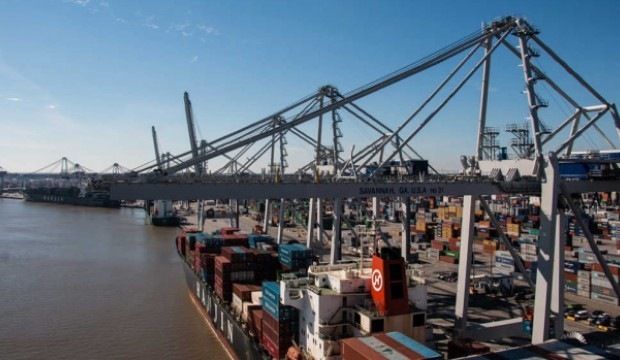GEORGIA DEEPWATER ECONOMIC REPORT

The total economic impact of Georgia’s deepwater ports consists of (1) direct spending by the ports industry, (2) direct spending by ports users, and (3) the secondary or indirect and induced spending—often referred to as the multiplier effects—created as direct expenditures by either the ports industry or ports users are re-spent. The ports industry is defined to include economic activity (spending) that involves the transportation of waterborne cargo and ports services, including the ports themselves, the companies engaged in deepwater transportation as well as companies that provide ship services, and companies that provide inland transportation of waterborne cargo. Ports investment (capital expenditures) for additions and/or improvements to Georgia’s deepwater ports also are included as part of the ports industry. This definition of the ports industry is identical to the definition used by the U.S. Department of Transportation, Maritime Administration in the MARAD Port Economic Impact Kit. Thus, the ports industry includes activities that take place on the vessel, at the terminal, and during the inland movement of cargo. Since the firms and enterprises that provide these activities locate in Georgia because of the existence of the ports, all of their activity (spending) can be counted as direct economic impact. Ports users are mainly manufacturers, wholesalers, distributors, and warehousing and storage firms that use the ports to transport materials and/or products. Although most users are importers and exporters, some ship materials or products to and/or from domestic locations. All of the economic activity (spending) generated by ports users whose decision to locate, remain, and/or expand in Georgia hinges on the presence of these deepwater ports can be counted as direct economic impact. But since most ports users are only partially dependent on the presence of Georgia’s deepwater ports, only a portion of their total economic activity is counted as direct economic impact. For example, firms that use Georgia’s deepwater ports due to cost advantages over other ports or other modes of transportation are only partially dependent on Georgia’s ports. Also, users that only ship a portion of their production and materials through Georgia’s deepwater ports are only partially dependent on the ports. To avoid double counting, ports users’ activity is defined to exclude their transportation expenditures associated with the waterborne cargo that is handled by Georgia’s ports industry. Secondary spending often is referred to as the multiplier effect of direct spending.
There are two types of secondary spending: indirect spending and induced spending. Indirect spending refers to the changes in inter-industry purchases as Georgia’s industries respond to the additional demands triggered by spending by either the ports industry or ports users. It consists of the ripples of activity that are created when the ports industry or ports users purchase goods or services from other industries located in the state. Induced spending refers to the additional demands triggered by spending by households as their income increases due to changes in production. Basically, the induced impact captures the ripples of activity that are created when households spend more due to the increases in their earnings that were generated by the direct and indirect spending. The sum of the direct, indirect, and induced economic impacts is the total economic impact, which often is expressed in terms of output (sales), state GDP, income, or employment. Output is gross receipts or sales, plus or minus inventory. Total output impacts are the most inclusive, largest, measure of economic impact. Because of their size, output impacts typically are emphasized in economic impact studies and receive much media attention. One problem with output as a measure of economic impact, however, is that it includes the value of inputs produced by other industries, which means that there inevitably is some double counting of economic activity.
Estimating the economic impact of Georgia’s deepwater ports involved two distinct steps. First, data regarding tonnage by type and capital expenditures were obtained from the Georgia Ports Authority. The tonnage and capital expenditure data were imported into the U.S. Department of Transportation’s MARAD Port Economic Impact Kit to estimate the direct, indirect, induced, and total economic impacts of the ports industry. Second, ports users’ spending was estimated. Ports users were surveyed in 2003 to determine the degree to which they depend on Georgia’s deepwater ports. To help correct for non-response and/or incomplete responses and to update the analysis, several types of government and administrative data were used to assess the proportion of revenue or sales in various industries that could be attributed to ports usage. The IMPLAN Version 3.0 economic impact assessment software system was used to estimate the indirect and induced economic impacts of the ports-related portion of spending by users. Finally, the statewide economic impact estimates were allocated to indvidual counties based on each county’s economic structure and PIERS trade data regarding county-level imports and exports (measured in terms of short tons and estimated value). Estimating the Ports Industry’s Economic Impact A revised version of the U.S. Department of Transportation’s MARAD port economic impact model that was built specifically for Georgia was used to estimate the direct, indirect, and induced economic impact of spending by the ports industry. A detailed discussion of the model, including its structure, methods, and use can be found in the twovolume MARAD Port Economic Impact Kit. The Georgia Ports Authority provided the fiscal year 2011 data on cargo volume (import and export) by mode of transportation for the Savannah and Brunswick facilities that the MARAD model required. The cargo volume reported for the Port of Savannah includes data for the Garden City and Ocean terminals. The cargo volume reported for the Port of Brunswick includes data for Colonel’s Island, Brunswick East River/Lanier Docks, and the Mayor’s Point Terminal. Table 1 summarizes cargo volume for cars, containerized cargo, breakbulk cargo, dry bulk cargo, and liquid bulk cargo.
Cargo volume is expressed on a per-vehicle basis for auto/vehicle cargo; a per-TEU (Twenty Foot Equivalent Unit) basis for containerized cargo; and a per-short ton (2,000 pounds) for breakbulk, dry bulk, and liquid bulk. In addition, the Georgia Ports Authority provided estimates of cargo volume for the private facilities/docks based on an analysis of data obtained from PIERS, and the estimates are summarized in Table 2. The Georgia Ports Authority also provided capital expenditures (ports investment) in FY 2014 for the facilities that it owns. Capital expenditures by the private facilities/docks are not included in this analysis, however.
The total economic impact of Georgia’s deepwater ports on output, GDP, income, and employment is summarized in Table 3. The direct, indirect plus induced, and the total economic impacts of Georgia’s deepwater ports in terms of output, income, and gross state product are reported in Table 4. Similarly, Table 5 and Table 6 report the employment and tax impacts, respectively. Table 7 reports the overall multiplier values for output, employment, income, and GDP. Table 8 reports the total economic impacts of cargo-based activity by mode of cargo at the Georgia Ports Authority’s operations in Savannah and Brunswick. Table 9 shows the ports industry’s employment impact by occupation. Table 10 details the employment impact of port users by industry.
Table 11 reports the total employment impact by county. More detailed tabulations of the economic impact of Georgia’s deepwater ports are included in Appendix 1. n Output Impacts n Measured in the broadest terms, the total economic impact of the Port of Savannah and the Port of Brunswick on Georgia’s economy is $84.1 billion, which is 9.6 percent of Georgia’s output in FY 2014. Out of the total, $4.1 billion (5 percent) represents the results from the ports industry, of which the GPA’s operations at the Port of Savannah contribute 84 percent. Ports users’ total output impact, however, is over nineteen times greater than that of the ports industry—$80 billion. Indeed, ports users account for 95 percent of the total output impact of Georgia’s deepwater ports. Of the FY 2014 total output impact, $50.7 billion represents initial spending, or direct economic impact; $33.4 billion is indirect and induced spending, or the re-spending (multiplier) impact. Dividing the FY 2014 total output impact ($84.1 billion) by initial spending ($50.7 billion) yields an average multiplier value of 1.66. On average, therefore, every dollar initially spent by either the ports industry or ports users generates an additional 66 cents for the state’s economy.
This study investigates the economic impact of Georgia’s deepwater ports, and finds substantial economic impacts in terms of output (gross receipts or sales), state GDP, income, employment, state and local tax revenues, and federal tax revenues. The findings are based on analytical methods that are standard in regional economics and economic consulting.
regards,
Bill Stankiewicz, email: bstankiewicz@portfreshlogistics.com
www.beBee.com BRAND AMBASSADOR , Phone: 1.404.750.3200
"
Articles from Bill Stankiewicz
View blog
OSHA's On-Site Consultation Program offers no-cost and confidential occupational safety and health s ...

Hello to all Bee's, · As a member here, I do love reading the many posts that are shared from beBee ...

SAVANNAH, Ga., August 12, 2019 · - · Intermodal cargo continues its powerful rise at the Georgia Por ...
You may be interested in these jobs
-

Healthcare Private Duty Nurse LPN
Found in: Lensa US P 2 C2 - 10 hours ago
Aveanna Avon Park, United StatesAveanna Healthcare Private Duty Nurse LPN - WeekendsJob Ref:191796Location:Avon Park, FL 33825Category:LPN/LVNLine of Business:PDSPay Rate:Starting at $25.00 per hourApplyRefer a FriendBackFind yourself here.Aveanna is compassion and passion rolled into one inspired purpose. It's ...
-
Operations Manager
Found in: beBee S2 US - 2 weeks ago
Xcel Energy Pueblo, United StatesAre you looking for an exciting job where you can put your skills and talents to work at a company you can feel proud to be a part of? Do you want a workplace that will challenge you and offer you opportunities to learn and grow? A position at Xcel Energy could be just what you'r ...
-

Pick Basic
Found in: beBee S2 US - 6 days ago
QData Miami, United States contractPick/Universe/Unidata/Unibasic Programming experience Expertise in Multi value database Programming through Universe/Unidata/Unibasic/Pick basic Universe Reality DB/Databasic Expertise in application development maintenance and enhancements experience on Unidata UNIVERSE and PICK ...

Comments
Bill Stankiewicz
6 years ago #1